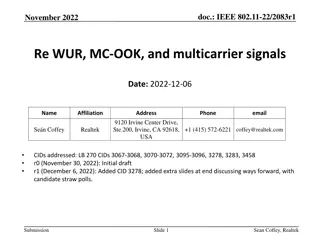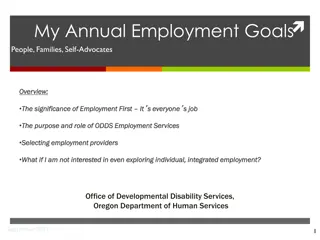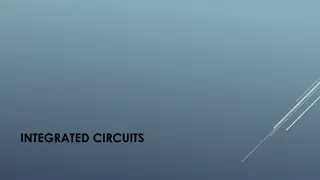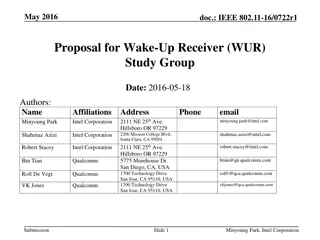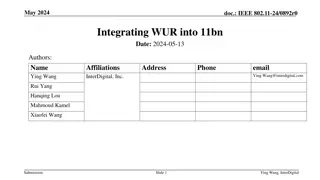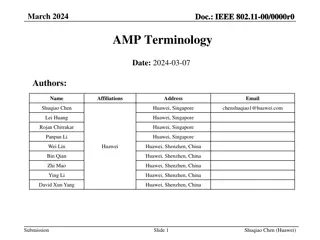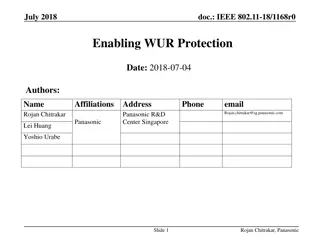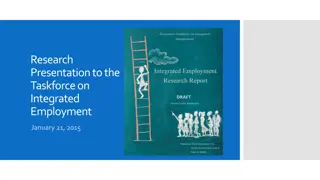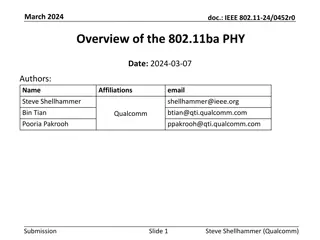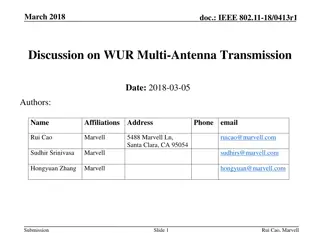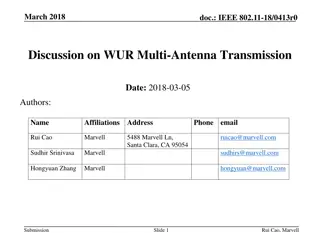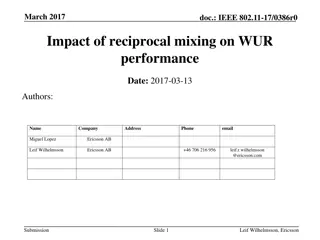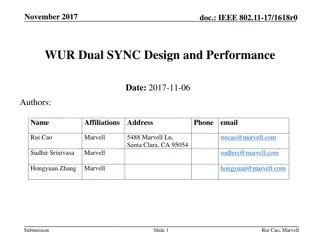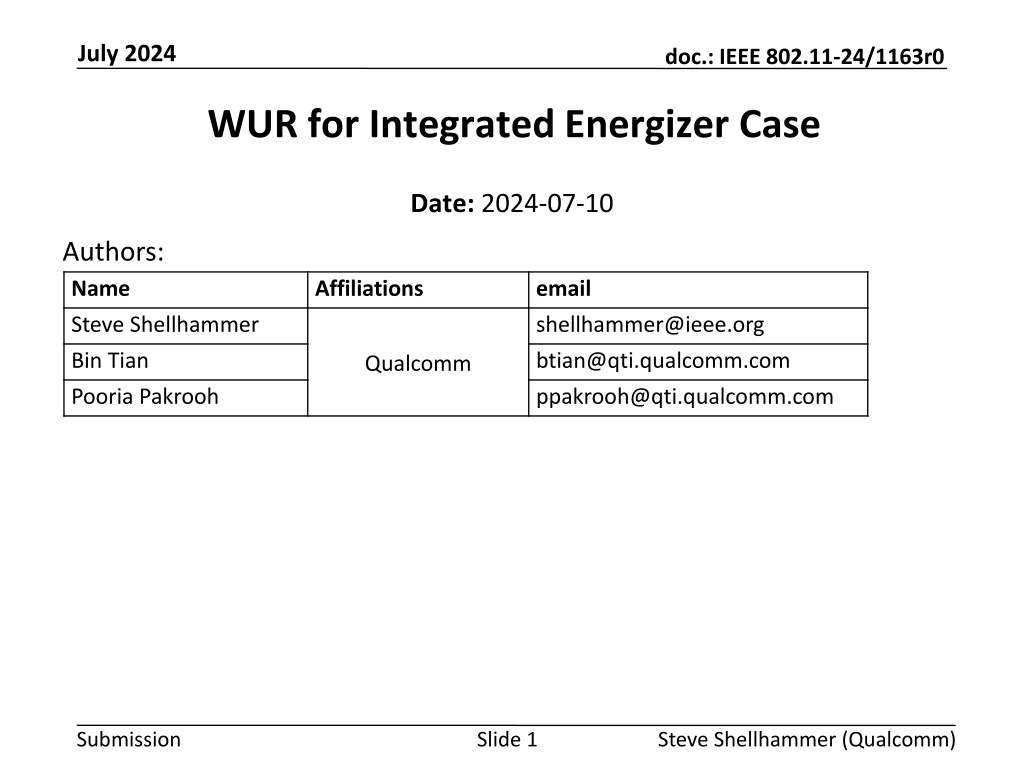
IEEE 802.11-24/1163r0 Integrated Energizer Case Analysis
Exploring the challenges and solutions for a limited link budget scenario when an AMP Reader integrates an Energizer in IEEE 802.11-24/1163r0. Details on adapting the WUR design for optimal performance in such cases are provided by the authors.
Download Presentation

Please find below an Image/Link to download the presentation.
The content on the website is provided AS IS for your information and personal use only. It may not be sold, licensed, or shared on other websites without obtaining consent from the author. If you encounter any issues during the download, it is possible that the publisher has removed the file from their server.
You are allowed to download the files provided on this website for personal or commercial use, subject to the condition that they are used lawfully. All files are the property of their respective owners.
The content on the website is provided AS IS for your information and personal use only. It may not be sold, licensed, or shared on other websites without obtaining consent from the author.
E N D
Presentation Transcript
July 2024 doc.: IEEE 802.11-24/1163r0 WUR for Integrated Energizer Case Date: 2024-07-10 Authors: Name Affiliations email Steve Shellhammer shellhammer@ieee.org Bin Tian Pooria Pakrooh btian@qti.qualcomm.com ppakrooh@qti.qualcomm.com Qualcomm Submission Slide 1 Steve Shellhammer (Qualcomm)
July 2024 doc.: IEEE 802.11-24/1163r0 Introduction In [1] we brought up that the link budget for the case where the AMP Reader has an Integrated Energizer, is significantly less than the case when there is either the Energizer is a separate device or the case where there is another energy source (e.g., light, thermal, etc.) Here we provide some ideas on how the WUR design can be adapted to this case when the link budget is limited by the Integrated Energizer Submission Slide 2 Steve Shellhammer (Qualcomm)
July 2024 doc.: IEEE 802.11-24/1163r0 Integrated Energizer Case Here the AMP AP integrates o Energizer o Downlink Transmitter o Uplink Receiver The wireless communication links only need to meet the Energizer link budget AMP AP AMP STA Note: The AMP AP can be a soft AP in a mobile device Submission Slide 3 Steve Shellhammer (Qualcomm)
July 2024 doc.: IEEE 802.11-24/1163r0 Estimated Link Budget for Integrated Energizer Parameter Comments Value Maximum Energizer TX Power This requires 6 dB Antenna gain. In practice, the value could be less. +36 dBm Minimum RF Harvesting Required RX Power Level From TIG Report [2] ?? dBm Maximum sub-1GHz Link Budget Difference between TX power and RX Power 59 dB Path Loss Difference between sub-1GHz and 2.4 GHz 8.5 dB Maximum 2.4 GHz Link Budget This is for maximum Energizer TX power and minimum RF Harvesting RX Power Level 67.5 dB In practice, the link budget for the Integrated Energizer case may be less Submission Slide 4 Steve Shellhammer (Qualcomm)
July 2024 doc.: IEEE 802.11-24/1163r0 Rough 802.11ba Link Budget For Reference Parameter Comments HDR Value LDR Value TX Power Regulatory Limits in ETSI and China 16 dBm 16 dBm Thermal Noise Floor Measured in 20 MHz -101 dBm -101 dBm Noise Figure Implementation decision. Large NF for Low-Power. 15 dB 15 dB Noise Power Level -86 dBm -86 dBm Required SNR (LDR) 802.11ba AWGN Simulations -1.5 dB -7.5 dB Receiver Sensitivity -87.5 -93.5 Link Budget Difference of TX Power and RX Power 103.5 109.5 This link budget is much larger than what is required for the Integrated Energizer case, by around 36 dB for the HDR and 42 dB for the LDR The choice of the Noise Figure is up to the implementer. The Task Group may want to discuss a reference value that can be used for calculations like this. Submission Slide 5 Steve Shellhammer (Qualcomm)
July 2024 doc.: IEEE 802.11-24/1163r0 Possible modifications for Integrated Energizer Case One modification is to increase the data rate since the SNR is higher o Note, a higher Noise Figure is possible in an implementation That will lead to much shorter packet duration We can also use a shorter Sync Field, since the SNR is higher Submission Slide 6 Steve Shellhammer (Qualcomm)
July 2024 doc.: IEEE 802.11-24/1163r0 Modulation In 802.11ba we used Multicarrier OOK (MC-OOK) so we could have both a low symbol rate and a 4 MHz Bandwidth We will move to a single-carrier OOK, so the bandwidth is now based on the symbol rate Here we keep the bandwidth at 4 MHz, but we can also consider a different bandwidth Submission Slide 7 Steve Shellhammer (Qualcomm)
July 2024 doc.: IEEE 802.11-24/1163r0 Power Spectral Density Single carrier OOK with a symbol rate of 2 MHz o Note: It is also possible to consider higher symbol rates Smoothed PSD with a simple Butterworth filter for spectral filtering Submission Slide 8 Steve Shellhammer (Qualcomm)
July 2024 doc.: IEEE 802.11-24/1163r0 Sync Field and Data Field Since the SNR is much higher than in 802.11ba, the Sync Field can likely be shorter than in 802.11ba Here we suggest that an 8-bit Sync Field could be used o More study would be needed Here we suggest keeping the Manchester encoding to simplify the receiver design Submission Slide 9 Steve Shellhammer (Qualcomm)
July 2024 doc.: IEEE 802.11-24/1163r0 Comparison with 802.11ba (HDR and LDR) Parameter Possible New Design 802.11ba HDR 802.11ba LDR Symbol Duration 0.5 s 2 s 2 and 4 s Number of Symbols in Sync Field 8 32 64 Data Rate 1 Mb/s 250 kb/s 62.5 kb/s Sync Field Duration 4 s 64 s 128 s Data Field Duration (6 Octet Payload) 48 s 192 s 768 s Sync & Data Field Duration (6 Octet Payload) 52 s 256 s 896 s Receiver Sampling Rate (Three samples per OOK Symbol) 6 MHz 1.5 MHz 1.5 MHz Because of the higher data rate, the packet duration of this proposed design is much shorter than that of the 802.11ba HDR or LDR packet Submission Slide 10 Steve Shellhammer (Qualcomm)
July 2024 doc.: IEEE 802.11-24/1163r0 Observations The PPDU is much shorter than in 802.11ba This leads to a shorter decoding time However, as we increase the sample rate at the receiver so that must also be considered Submission Slide 11 Steve Shellhammer (Qualcomm)
July 2024 doc.: IEEE 802.11-24/1163r0 Power Consumption Comparison Here we make some observations about the Receiver power consumption for the two specifications: Possible New Design and 802.11ba (HDR) Circuits Comparison Comments RF Circuits Similar Since both designs operate in 2.4 GHz it is expected that the RF power consumption would be similar LNA Noise Figure Similar In the high SNR case, the LNA Noise Figure could be quite high for both designs. Analog Baseband Similar Given that the bandwidths are the same the analog baseband circuits would be similar. Sampling Rate Higher Rate for Possible New Design, but similar number of total samples Unclear if this would be similar or different with the new design. Sync Field Detection This should be lower in the Possible New Design due to the shorter Sync Field Sync Field detection is one of the major digital power consumption factors. So, this maybe a significant factor. Data Field Decoding Similar Use of Manchester encoding would be similar in both cases. Similar number of samples per symbol. Submission Slide 12 Steve Shellhammer (Qualcomm)
July 2024 doc.: IEEE 802.11-24/1163r0 SNR Feasibility The difference between the Possible New Design data rate and the 802.11ba LDR data rate is 16x This correspond to a required higher SNR of 12 dB According to the SNR link budget comparison we have approximately 40 dB higher SNR Hence, this well within feasibility range It is possible to even consider a higher data rate/symbol rate, if the PSD fits well within the 20 MHz spectral mask For example, 2 Mb/s with 0.25 s symbol duration However, that will also increase the receiver sampling rate Submission Slide 13 Steve Shellhammer (Qualcomm)
July 2024 doc.: IEEE 802.11-24/1163r0 Harmonization This possible new downlink design would be harmonized to work with all the various possible uplink designs, for the case when we have an Integrated Energizer This is not focused to pair with any specific uplink design Submission Slide 14 Steve Shellhammer (Qualcomm)
July 2024 doc.: IEEE 802.11-24/1163r0 Conclusions We have proposed several modification relative to 802.11ba for the Integrated Energizer case. These include: o Changing from MC-OOK to single-carrier OOK o Increasing the symbol rate to 2 MHz o Increase data rate to 1 Mb/s o Shortening the Sync Field to 8 bits or something similar This would reduce the PPDU duration significantly It may also lead to lower power receiver implementations Submission Slide 15 Steve Shellhammer (Qualcomm)
July 2024 doc.: IEEE 802.11-24/1163r0 References 1. Pooria Pakrooh, Steve Shellhammer and Bin Tian, Thoughts and Questions on AMP PHY, IEEE 802.11-24/0867r0, May 2024 2. Weijie Xu, et. al., Technical Report on support of AMP IoT devices in WLAN, IEEE 802.11-23/2203r1, November 2023 Submission Slide 16 Steve Shellhammer (Qualcomm)


